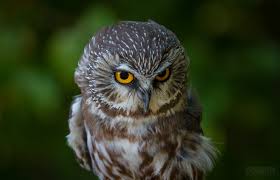Great Horned Owl
Category: Owl

Facts about Great Horned Owl. "Scientific name for Great Horned Owl is Bubo virginiaus". Great Horned Owl is a Bubo type of owl that belongs to the Strigidae family. The Great Horned Owls hail from the United States, and they are very adaptable birds with a huge range and are the most extensively spread true owls in the America. The Great Horned Owl is one among the original nesting birds in North America, habitually laying eggs weeks or even months earlier than other raptorial bird varieties. They are largely found in deserts, forests, wetlands, backyards, grasslands, cities, and approximately any other semi-open home between the tropics and the Arctic.
Features of Great Horned Owl
Great Horned Owl is a big size owl and when it is matured, it attains the maximum body length, ranging from 18 1/18 inches to 24 7/8 inches, with the body mass that ranges from 32.1 pounds to 88.2 pounds. These birds have a wingspan between 39 7/8 inches and 57 7/8 inches.
The Great Horned Owl has a big, thick body, with two famous feathered tufts on their head. They have a mottled gray-brown color body, with reddish brown color face and a tidy white patch on their throat. The white color throat may continue as a strip, running down the middle part of the breast even when the owls are not showing, which in chiefly pale owls can broaden at the stomach into a huge white area.
The general color tone of the Great Horned Owl varies from sooty to pale, according to the region. Generally, the owl is colored for camouflage, and its underparts are usually light with a little brown horizontal barring. The upper parts and the upper wings of the bird are rounded and broad, generally bearing heavy, composite darker markings. During the flight, the small bill and the rounded head combine to make a dull-headed silhouette.
The horns of the Great Horned Owl are neither horns nor ears, and they are just tufts of feathers. Ear tufts are divided by all affiliates of its genus, including approximately exactly half of over 200 existing owl varieties. The principle of ear tufts is not completely understood, even though the assumption is that they serve as a visual signal in protective and social-sexual contacts with other owls.
These owls boast a facial disc that is well remarked attributable to a dark border that culminates in bold, black-colored brackets at the sides of the facial disc. The facial disc of the bird may be reddish, gray or brown in color, demonstrating substantial geographic, ethnic and individual distinction.
Diet of Great Horned Owl
Great Horned Owls mostly feed on hares and rabbits, mice, rats and voles, even though they freely hunt any animal they can surpass, chiefly other rodents and small creatures. They also feed on bigger and average-sized creatures, different birds, amphibians, reptiles and invertebrates.
Behavior of Great Horned Owl
Great Horned Owl breeds are nocturnal, which means that they come out during the night hours in search of food. They can be observed at dusk, sitting on tree limbs or fence posts at the rims of open regions, or flying across fields or roads with firm, deep beats of their circular wings. Their call is a profound, stuttering sequence of four to five howls.
The average lifespan of the Great Horned Owl ranges from 11 years to 13 years.

 Back To Category Owl
Back To Category Owl